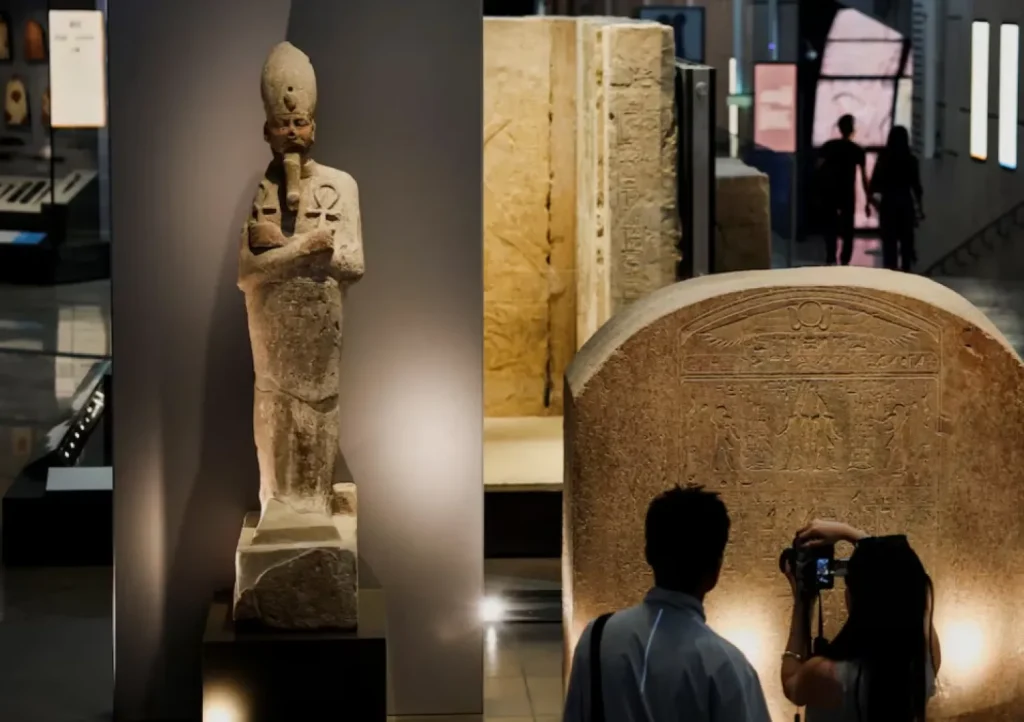After two decades of planning and delays, Egypt is finally set to inaugurate the Grand Egyptian Museum (GEM). Located near the base of the Giza Pyramids, this massive $1-billion landmark is the world’s largest museum dedicated solely to one civilization.
The GEM will officially open its doors on Saturday, marking a huge moment for Egypt’s cultural influence and ambitious tourism goals.
Monumental Design and Historic Scale
The striking design of the GEM was created by the Irish firm Heneghan Peng Architects. The building features a monumental glass façade. This design draws inspiration from the precise geometry of the famous pyramids nearby.
Inside, the entrance welcomes guests with a towering 36-foot-tall granite statue of Ramesses the Great. Visitors ascend a majestic grand staircase.
This staircase is lined with statues representing thousands of years of ancient history. All paths lead to a viewing point with a panoramic vista of the pyramids.
King Tutankhamun’s Collection Fully Displayed
The most anticipated feature of the museum is the complete collection of King Tutankhamun. A renowned Egyptologist and former Minister of Antiquities emphasized the museum’s importance.
“Why this museum is so important, and everyone is waiting for the opening? Because of Tutankhamun,” he stated, adding that the museum will truly make the ancient objects “alive.”
For the first time since the 1922 discovery of the tomb by Howard Carter, all 5,000 objects from Tutankhamun’s burial chamber will be displayed together. These pieces occupy two dedicated exhibition halls.
- Restoration: Many treasures underwent meticulous restoration. This work took place at the GEM’s cutting-edge conservation center.
- Safety: The head of the wood restoration lab confirmed the successful transfer of several major items. This included the pharaoh’s six chariots and three funerary beds. These priceless artifacts reached the museum with a safety level of 100%.
Key highlights include the iconic funeral mask of gold, the boy king’s golden throne, and the gold-covered sarcophagus.
Another central exhibit is the 4,600-year-old solar boat of King Khufu. It was transported intact to the GEM on a custom vehicle from its original location next to the Great Pyramid.
A Major Catalyst for Tourism
The GEM is poised to revolutionize Egypt’s tourism sector. It features 50,000 artifacts, covering history from prehistoric times through the Roman era. The exhibition space spans 24,000 square meters. This size significantly surpasses the displayed area of major museums like the Louvre.
The CEO of the Grand Egyptian Museum anticipates a huge boost in visitors. He projected the museum “is expected to increase the number of tourists to Egypt,” potentially by “at least 10% or 20%.”
The opening aligns with Egypt’s ambitious goal of reaching 30 million tourists annually by 2032. The country welcomed a record 15.7 million visitors in 2024. To manage the expected crowds, authorities have overhauled the surrounding infrastructure. This included upgraded roads, construction of a new metro station, and improvements to the nearby Sphinx International Airport.
Cultural Mega-Project Fulfills Long-Awaited Promise
Construction on the immense cultural project began in 2005. It faced lengthy postponements due to both the 2011 revolution and regional instability. Now, with world leaders expected at the opening ceremony, Egypt is ready for its most significant cultural unveiling of the century.
The museum strategically sits at the center of ancient history and modern revival. It connects directly to the Giza plateau via pedestrian paths and eco-friendly transportation. Museum administrators estimate daily visitor numbers will reach 15,000 to 20,000.
The Grand Egyptian Museum is more than a repository for ancient relics. It stands as a powerful statement of national pride. It is a long-awaited promise fulfilled and a new, majestic gateway for the world to rediscover Egypt’s extraordinary past.
New Policy: Tinubu Approves 15% Import Duty on Petrol and Diesel























